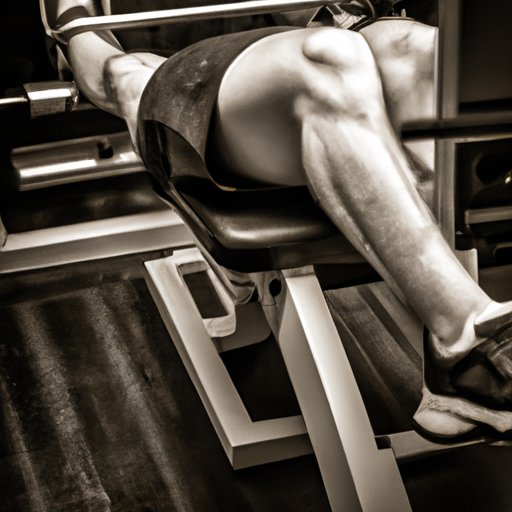
What is a Good Leg Press Weight?
If you are interested in building lower body strength and increasing overall muscle mass, then you have likely considered adding leg presses to your workout routine. Leg presses are an essential part of resistance training, and are an excellent way to target the quadriceps, hamstrings, and glutes. But, what weight is best when performing these exercises? In this article, we will explore the benefits of leg press weight training, how to find the right weight for you, the science behind the ideal load and common mistakes to avoid.
The Benefits of Leg Press Weight Training: How Heavy Should You Go?
Leg press weight training offers a range of benefits, including muscle growth, strength improvement and increased endurance. Different muscle fibers respond differently to different weight loads. Lower rep ranges with higher weight loads tend to work the fast-twitch muscle fibers, which are responsible for explosive movements and strength development. In contrast, high rep ranges with lighter weights tend to work the slow-twitch muscle fibers, which are responsible for endurance.
The weight that you should use for leg presses depends on your goals, experience, and physical ability. If you are new to leg presses, start with a weight that is comfortable and feels manageable. As your strength improves, you can start to increase weight to continue seeing benefits.
Finding Your Optimal Leg Press Weight for Maximum Gains
To find your ideal leg press weight, it’s essential to consider your training level and experience. Newcomers to resistance training should start with a weight that feels comfortable and manageable. If you’re experienced in resistance training, you can begin with a heavier weight that is challenging from the start.
To determine your ideal weight, start by performing the leg press exercise with a weight that you are comfortable with. If you can easily complete 10-12 repetitions, then it’s time to increase the weight a bit. You should aim to perform three sets of 10-12 repetitions at your chosen weight load.
The Science Behind Leg Press Weight: How to Determine the Ideal Load
When it comes to leg press weight, it’s crucial to understand the science behind the ideal load. The Progressive Overload Principle states that to continue to make gains, we have to continually increase the weight that we lift in our resistance training exercises. The Progressive Overload Principle suggests that you should increase the weight by 5-10% each time you are ready to progress to a new weight load.
The right weight for the leg press also depends on your body mechanics. The optimal weight for leg presses is one that allows you to perform the exercise with correct posture and technique. If you have to alter your body mechanics or engage incorrect muscles to lift the weight, then it’s too heavy.
Don’t Underestimate the Power of Your Leg Press Weight: Tips for Choosing the Right Load
When it comes to choosing the right load for leg press training, it’s essential to consider several factors. First, consider your goals. Are you looking to build strength, muscle mass or endurance? Think about what you want to achieve from the leg press, and then choose the weight accordingly.
Technique is also important when it comes to leg press training. Proper technique involves maintaining a neutral spine and keeping your feet hip-width apart to avoid stressing your lower back. When choosing your load, you should select a weight that allows you to perform the exercise with correct posture and technique. Maintaining proper form ensures that you are targeting the correct muscle groups and avoiding injury.
To adjust your weight, you should aim to increase by 5-10% at each workout. It can be tempting to increase the weight by a more significant margin to challenge yourself, but this can lead to injury or overtraining. Listen to your body and increase the weight gradually over time.
A Beginner’s Guide to Leg Press Weight: How to Start and Progress Safely
If you’re new to leg press weight training, then it’s essential to start slowly and progress safely. To start, select a weight that feels comfortable to lift. Always begin with a light weight to avoid overstraining your muscles. When lifting, aim to maintain correct posture and technique and avoid your body compensating with incorrect movement.
As you progress, aim to increase the weight by 5-10% at each workout. This gradual increase will ensure that your muscles have time to build strength and avoid overtraining or injury. As always, listen to your body and avoid overexerting yourself.
Common Mistakes to Avoid When Choosing Your Leg Press Weight
Choosing the right weight for leg presses requires a balance of strength, good posture, and the ability to maintain correct technique. One of the most common mistakes is selecting a weight that is too heavy and compromising posture while performing the exercise. This can place undue strain on your lower back and lead to injury.
Choosing a weight that is too light is also a mistake as it will not challenge your muscles and lead to limited gains. Remember, to achieve gains in resistance training, your muscles need to be challenged past their current ability. Too light a weight will not provide the necessary resistance to build muscle mass or strength.
Conclusion
To achieve optimal results during leg press weight training, you need to select a weight that is challenging but still safe. Selecting the proper weight depends on several factors such as experience, physical ability, technique, and goals. Remember to listen to your body and aim to increase weight loads steadily over time. Proper technique is key, so always maintain correct posture and ensure that you are not compensating with incorrect movement.




